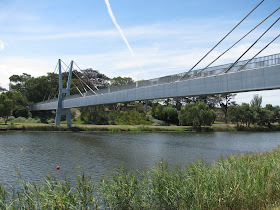During the recent floods, the bridge over the Barwon at Breakwater was, as usual, out of action forcing a significant amount of traffic to use other crossings. Imagine the inconvenience then, when the only real bridge over the river - the Barwon Bridge on Moorabool Street - was swept away in the major floods of May, 1852. It had only been built in 1848.
 |
| Construction of the new bridge at Breakwater |
The current bridge - widened in the 1960s and again last year to meet requirements for the International World Cycling Championships held in Geelong - was built in 1926 to allow trams to cross.
As a quick search of Wikipedia will tell you, that in addition to the Barwon Bridge there are a number of bridges crossing the Barwon along its lower reaches. There is the controversially rebuilt Barwon Heads bridge at the mouth of the Barwon, joining Barwon Heads and Ocean Grove. In addition to the Barwon Bridge, Geelong has the ovoid sewer aqueduct, the Breakwater Bridge and the rail bridge which crosses both the river and the road bridge at this point, the James Harrison Bridge, the McIntyre Bridge, the Queen's Park Bridge and even the little foot bridge which crosses the Barwon at Fyansford. Then there is the soon to be completed replacement for the Breakwater Bridge which will re-align Breakwater road and flood-proof the river crossing at that point.
 |
| John M McIntyre Bridge |
John M McIntyre after whom the bridge was named was the Engineer-in-chief of the Geelong Waterworks (precursor to Barwon Water) and was involved in the the construction of the West Barwon Dam and reservoirs at Bostock and Lal Lal and extension works at the Wurdee Boluc Reservoir. The bridge which bears his name also provides pedestrian access across the river and - if memory serves me correctly - makes a handy reference point on the rowing course. Word has it that once your boat reaches the "Sh*!t Bridge" you row hell for the finish line.
 |
| Queen's Park Bridge |
The Queen's Park Bridge is another historically significant bridge across the Barwon. The present single-lane steel structure dates to 1930. The site was initially serviced by a punt and was used as a cattle crossing with a wooden bridge built for the purpose in 1861. This was twice washed away in floods, first in 1870 and again in 1909. Purely functional are the new twin bridges which cross the river to the west of town. They were built in 2009 as part of the Geelong Ring Road which allows coastal traffic to avoid the congestion of local roads through the city.
Likewise, the James Harrison Bridge which crosses the river just upstream from the original Barwon Bridge, is designed purely for road traffic. Although this does not stop it being taken over for an hour or two on the third Sunday in November by the several hundred runners who have for the past two years completed the "Run Geelong" fun run event.
 |
| Pollocksford Bridge |
Once out of Geelong, the bridges become more widely spaced. Heading further upstream, the first is the Merrawarp Road Bridge and then the Pollocksford Bridge - a five span bluestone bridge built in 1859. The next crossing point is on the Inverleigh-Winchelsea Road just out side of Inverleigh, near the confluence of the Leigh and Barwon Rivers.
 |
| Winchelsea Bridge |
Other bridge crossings I have yet to investigate include the Winchelsea-Deans Marsh Road which appears to cross a shallow stretch of the river at a natural ford, Kildean Lane and Conn's Lane. Another road bridge lies just outside of Birregurra on the Birregurra-Deans Marsh Road, then one on the Colac-Murroon Road and Dewing's Bridge Road. All appear to be modern concrete structures of little aesthetic interest.
At this point I become somewhat confused, but know of at least one more bridge just past Barwon Downs and another on the outskirts of the township of Forrest, below the West Barwon Dam. Then finally, at the base of the dam is a little foot bridge designed for pedestrian access.
In general it would seem that most of the bridges over the Barwon have been built for function rather than appearance, however several have long histories which tie in with the story of Geelong and the farming communities through which the river flows.
No comments:
Post a Comment